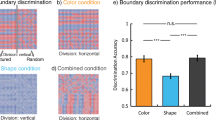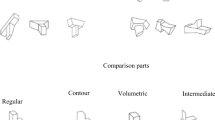Summary
A white disk lacking visible texture was placed in several types of visibly structured surrounds. S responded by drawing the shape of the target and by representing the proportions. The results indicate that shape and proportion responses are distinct from each other. Changes in the nature of the area external to the area seen bounded by the edge affect shape responses more than proportion responses.
Similar content being viewed by others
References
ALLPORT, F. L. Theories of perception and the concept of structure. New York: Wiley, 1955.
BARTLEY, S. H. Principles of perception. New York: Harper, 1958.
BRUNSWIK, E. Perception and the representative design of psychological experiments. Berkeley: Univer. of Calif. Press, 1956.
GIBSON, J. J. Perception as a function of stimulation. In S. Koch (Ed.), Psychology: A study of a science, Vol. 1. New York: McGraw-Hill, 1959. Pp. 456–501.
HASTORF, A. H. The influence of suggestion on the relationship between stimulus size and perceived distance. J. Psychol., 1950, 29, 195–217.
LETTVIN, J. Y., MATURANA, H. R., McCULLOUGH, W. S., and PITTS, W. H. What the frog’s eye tells the frog’s brain. Proceed. I.R.E., 1959, 47, 1940–1951.
LUDVIGH, A. Perception of contour: I. Introduction. U. S. Naval Sch. Aviat. Med. Res. Rep., #1953, Rep. No. NM 001 075.01.04, Joint Report No. 4, 9p. (a)
LUDVIGH, A. Perception of contour: II. Effect of rate of change of retinal intensity gradient. U. S. Naval Sch. Aviat. Med. Res. #1953, No. NM001 075.01.05, Joint Report No. 5, 5p. (b)
MILLER J., and BARTLEY, S. H. Object shape as influenced by instrumental magnification. J. gen. Psychol., 1954, 56, 141–146.
NELSON, T. M., and BARTLEY, S. H. The perception of form in an unstructured field. J. gen. Psychol., 1956, 54, 57–63.
NELSON, T. M., BARTLEY, S. H., and BOURASSA, C. M. The effect of areal characteristics of targets upon shape-slant invariance. J. Psychol., 1961, 52, 479–490.
O’BRIEN, V. Contour perception, illusion, and reality. J. opt. Soc. Amer., 1958, 48, 112–119.
THOULESS, R. H. Phenomenal regression to the real object. I. Brit. J. Psychol., 1931, 21, 339–359. (a)
THOULESS, R. H. Phenomenal regression to the real object. II. Brit. J. Psychol., 1931, 22, 1–30. (b)
WHORF, B. L. Language, thought and reality. New York: Wiley, 1956.
WERNER, H. Studies on contour. I. Qualitative analysis. Amer. J. Psychol., 1935, 47, 40–64.
Author information
Authors and Affiliations
Additional information
The authors thank Mr. Raleigh Huizinga for participating in gathering the data.
Rights and permissions
About this article
Cite this article
Nelson, T.M., Bartley, S.H. A theoretical study of shape and proportion. Psychol Rec 12, 67–73 (1962). https://doi.org/10.1007/BF03393442
Published:
Issue Date:
DOI: https://doi.org/10.1007/BF03393442




